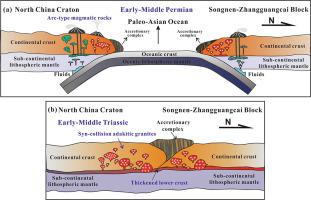Gondwana Research ( IF 6.1 ) Pub Date : 2021-08-08 , DOI: 10.1016/j.gr.2021.08.001 Yan Jing 1, 2 , Hao Yang 1, 2 , Wen-chun Ge 1, 2 , Yu Dong 1, 2 , Zheng Ji 1, 2 , Jun-hui Bi 3 , Hong-ying Zhou 3 , De-he Xing 4

|
There is a broad consensus that the Solonker suture zone marked the final closure of the eastern Paleo-Asian Ocean, which led to the formation of the eastern segment of the Central Asian Orogenic Belt (CAOB). However, when and how the final closure occurred still remained controversial. Located in a key position in the southeastern CAOB, the Early Mesozoic magmatic rocks along the northern margin of the North China Craton provide a crucial window to evaluate the subduction and final closure processes of the eastern Paleo-Asian Ocean. To address these issues, data on geochronological, whole-rock geochemical, whole-rock Sr-Nd and in situ zircon Hf isotopic study of the Early Mesozoic granites, as well as major-trace elements compositions of the apatites are reported here. Zircon U-Pb dating results showed that our studied granites were emplaced in the Middle Triassic (243.1–242.6 Ma). These granites have high Sr (250–652 ppm) contents, low heavy rare earth elements (HREEs), Yb (0.46–0.77 ppm) and Y (4.48–8.15 ppm) contents, and show high Sr/Y and (La/Yb)N signatures (36–108 and 21–35, respectively), with negligibly negative to moderately positive Eu anomalies (δEu = 0.80–1.36), indicating adakite-like affinities. Most of these granite samples are characterized by high K2O contents (3.30–4.83 wt%), and belong to the high-K calc-alkaline and shoshonitic series, with peraluminous affinities (A/CNK = 1.02–1.28). Besides, their low MgO (0.10–0.34 wt%), Cr (0.99–3.50 ppm), and Ni (0.96–2.40 ppm) contents indicate a thickened continent crustal origin, rather than subducting slab-derived or delaminated lower crust-derived melts. Analyzed granite samples yielded in situ zircon εHf (t) values (–8.3 to + 5.8) and whole-rock εNd (t) values (–4.38 to –5.69), with predominately negative values, indicating mixture sources of major recycled old components and limited juvenile crustal materials. Their parental magma was originated by partial melting of thickened lower crust, under garnet amphibolite facies conditions. Thickened crust in the southeastern CAOB yielded crustal thickness of ~54–64 km estimated from (La/Yb)N ratios of these lower crust-derived granites. These constraints, in conjunction with the E-W trending collision-related adakitic granitoids (250–243 Ma) along the southeastern CAOB, and other geological evidence, recorded a tectonic transition from this prolonged subduction to final closure of the eastern Paleo-Asian Ocean.
中文翻译:

东古亚洲洋的最终闭合何时发生:来自中亚造山带东南部早-中三叠世埃达克质花岗岩的最新约束
普遍认为,索伦克缝合带标志着古亚洲洋东部的最终闭合,导致了中亚造山带(CAOB)东段的形成。然而,最终关闭的时间和方式仍然存在争议。华北克拉通北缘早中生代岩浆岩位于中亚盆地东南部的关键位置,为评估古亚洲东部洋的俯冲和最终闭合过程提供了重要窗口。为了解决这些问题,地质年代学、全岩地球化学、全岩 Sr-Nd 和原位数据此处报告了早中生代花岗岩的锆石 Hf 同位素研究以及磷灰石的主要微量元素组成。锆石 U-Pb 测年结果表明,我们研究的花岗岩位于中三叠世(243.1-242.6 Ma)。这些花岗岩具有高 Sr (250–652 ppm) 含量、低重稀土元素 (HREE)、Yb (0.46–0.77 ppm) 和 Y (4.48–8.15 ppm) 含量,并显示出高 Sr/Y 和 (La/Yb) ) N 个特征(分别为 36-108 和 21-35),具有可忽略不计的负至中度正 Eu 异常(δEu = 0.80-1.36),表明类似埃达克石的亲和力。大多数这些花岗岩样品的特点是高 K 2O 含量 (3.30–4.83 wt%),属于高 K 钙碱性和钾长石系列,具有过铝的亲和力 (A/CNK = 1.02–1.28)。此外,它们的低 MgO (0.10–0.34 wt%)、Cr (0.99–3.50 ppm) 和 Ni (0.96–2.40 ppm) 含量表明大陆地壳起源增厚,而不是俯冲板片衍生或分层的下地壳衍生熔体. 分析花岗岩样品得出原位锆石 ε Hf (t) 值(–8.3 至 + 5.8)和全岩 ε Nd(t) 值(–4.38 至–5.69),主要为负值,表明主要回收的旧组件和有限的新生地壳材料的混合来源。它们的母岩浆起源于加厚的下地壳在石榴石角闪岩相条件下的部分熔融。CAOB 东南部加厚的地壳产生了约 54-64 公里的地壳厚度,根据这些下地壳衍生花岗岩的(La/Yb) N比率估计。这些限制与沿 CAOB 东南部的 EW 趋势碰撞相关的埃达克质花岗岩 (250-243 Ma) 以及其他地质证据一起,记录了从这种长期俯冲到古亚洲洋东部最终闭合的构造转变。


























 京公网安备 11010802027423号
京公网安备 11010802027423号